Users and bots can be assisted in finding answers through pyramid hierarchy structure using geometry: click shallow depth, descriptive URLs, and purposeful internal links. This makes your inner structure the silent growth engine with a blueprint of user movement.
The clear copy that delivers. When a website soars, everybody applauds the flashy graphics or the clever ads. However, the quiet hero is the site architecture sitting in the shadows. It wires the whole thing together and ensures that, the moment a visitor or a search engine slides in, the right pages light up like a bright welcome sign. Get this layer right, and you feel like a genius. Mess it up, and irritation walks through the door with everybody’s clunky finding-the-next-button dances.
So, what is architecture? Simply, it’s the map with the red dots to match every must-see page your site has. Pages, layers, links, button warehouses, and breadcrumbs all sit inside a game plan that says, “this is easy, keep moving!” Therefore, building this structure takes sketching, numbers, and the same soft thinking that helps the happiest “all the family” craft stores keep order—even down to finding parking.
What is Site Architecture

Think of a college library. For example, clear aisles, genres strapped, subgenres in duotone order, and the gaps calmly naked. That’s your site when load-ready. However, one broken spine or a random art history major left holding a map, and the entire room is apologizing. A site that skipped architecture? It’s a cat with a hangover joyfully up-ending the shelves. Consequently, a tower of pages—each a potential answer—gets camouflaged by its own disaster. In short, show this library-loving visitor the routes you map, or you might as well welcome tumbleweeds down your homepage.
This digital blueprint has two key building blocks:
- Categorization: Picture templating pages by theme. It’s like organizing a garage sale: all the books go on one table, toys on another, and so on, from the biggest categories down to the coolest, most specific finds, just like the neat aisles in your favorite store.
- Linking: These are the spoken roads connecting our pages to each other. Each link acts like a friendly sign, guiding party guests and search-engine spiders alike so no one ever has to ask for directions. As a result, how tidy or tangled the web of connections is can either stunt the reach of your posts or send them soaring the moment they go live.
Design for Users and Robots
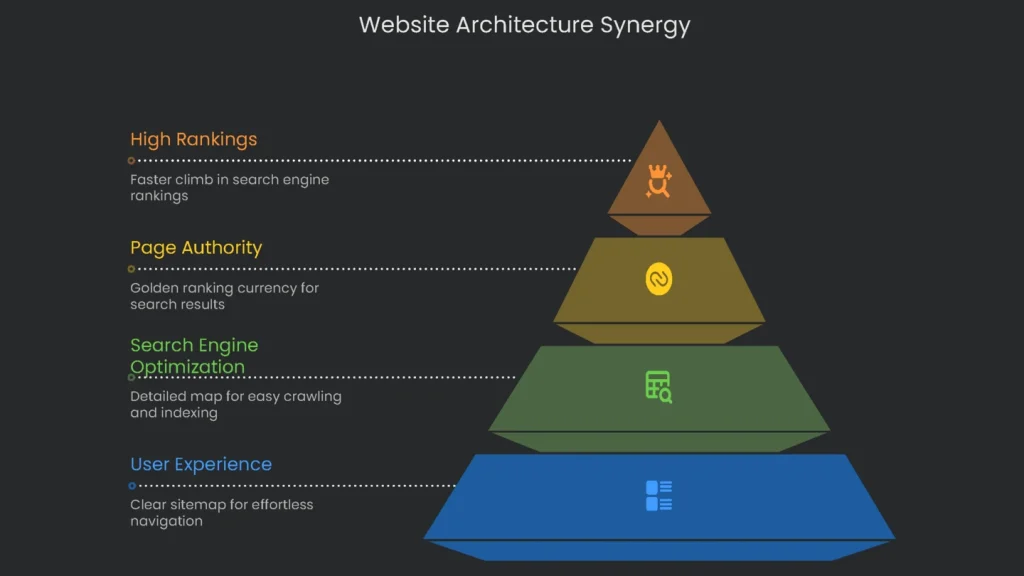
A top-notch structure is a two-customer store: the one on the screen and the helpful crawler snooping behind the scenes. Their requests sound different; however, their end goals match tightly. Consequently, you get fireworks of synergy when the architecture is on point.
For Users (UX)
Everyone in the party is racing to score tacos or directions to the next ride. A smart sitemap acts like a brightly lit concession-stand map, clear to anyone. When the links match the way guests already think, the clicks feel effortless. Therefore, questions fade, and they stay long enough to buy the official tour. Flip it and guests stumble. Zap—then they’re gone, and money, forms, or lessons are left behind.
For Search Engines (SEO)
Think of your website’s structure like a detailed treasure map for search engines such as Google. Best of all, it’s the secret building block of technical SEO. If you get it right, the search engine can more easily crawl, collect, and index every page. Consequently, the crawling bots glide through connected paths, grabbing content and figuring out which pages deserve the biggest spotlight. It’s also how you pass around page authority, a golden ranking currency for appearing high on search results.
Because of this connection, it’s a win-win for users and for SEO. Lay out your website for the best user journey. As a result, the algorithms reward the same setup. When users zoom through your content, stick around longer, and sample more pages, search engines notice the thumbs-up and mark your site as high quality. Eventually, your pages gather authority and climb the rankings faster.
The Pyramid for Simplicity & Scale

The most successful website architectures rest on a simple, logical ladder of pages. This design is often visualized as a tall pyramid. Picture the wide base representing your strongest entry pages and the narrow top holding the most specific, in-demand content. Therefore, users and bots alike can easily see where to go next. What’s even cooler is this structure lets your site keep growing—new treasure can be added to the pyramid without the map getting cluttered.
How the Pyramid Hierarchy Works
The pyramid structure starts wide at the top and narrows down. You begin with big ideas and work your way down to tiny details. Consequently, everything stays organized in a way that’s easy for people or robots to read.
- The Apex (Top): The Homepage. The top level is the homepage. This is where everyone arrives first. Therefore, the homepage explains what the whole site is about and links to the biggest topics.
- The Core (Middle): Main Categories. Right under the homepage are the main categories like “Services,” “Products,” “About Us,” and “Blog.” Each of these pages is like a big doorway to a section of the site.
- The Foundation (Bottom): Sub-categories & Pages. Under the big categories, you find more details—sub-categories and single pages or blog posts. For example, you might travel this way: Homepage > Services > SEO > Technical SEO Audit.
Putting things in this way makes it easy to move from a big, general idea down to the nitty-gritty. It also helps search engines see how everything is connected.
Building a Scalable Website
One of the coolest perks of the pyramid model is that it was made to grow. Websites aren’t static; they add new services, products, and stories all the time. If you start building on soggy ground, the whole thing collapses into chaos. The pyramid model hands you a solid blueprint. Next, you map out broad categories at the top and fill in the smaller subcategories beneath them. When you need to add something new, you know just where it belongs—no shuffling columns or missing information. Consequently, you save yourself the hassle and the big price tag of a rebuild.
Another smart part of this plan is how it sends page credibility where it needs to go. Your homepage, with all its external links, is the most trusted. In this model, it passes that trust down. It links to the major categories. Those categories direct visitors—and authority—to sub-categories and finally to stand-alone pages. As a result, search engines know which pages deserve to be seen first, which makes top results more likely.
A ‘Flat’ Structure
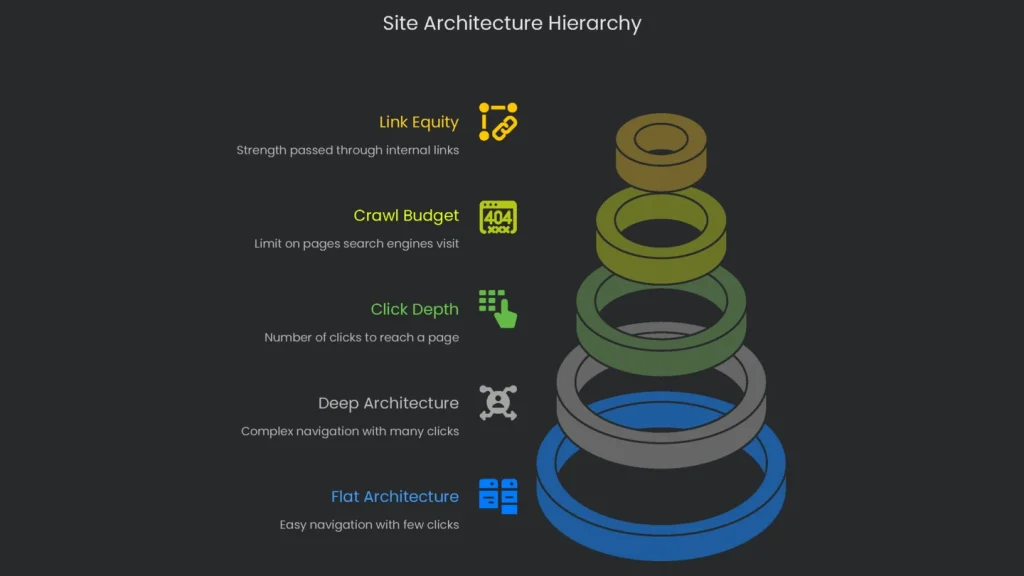
Even when a pyramid puts leaders at the top, we still want a “flat” layout for everyday folks climbing the site. That doesn’t mean ditching leaders. It means keeping every page a quick hop away. The tool we need for this is click depth—how many clicks separate the homepage from a certain page. Nail this number and both readers and search engines win.
Flat and Deep Architectures
Let’s picture your site’s map. It can be flat or deep.
- Flat Architecture: Picture a radar dish. Most pages reach folks in three or four hops from the homepage. The dish is wide and doesn’t reach fifty clicks straight down. Consequently, this is the go-to model. It sails for both easy surfing and happy search engines.
- Deep Architecture: Think of the adolescent kid’s bedroom. Unless you hike through four narrow, messy hallways, you won’t find the bedtime book. Users are lost. Meanwhile, search engines think the kid doesn’t even want that book read, so they forget the page is buried.
Search engines serve the radar-dish pages first. Meanwhile, users dislike climbing click towers. Therefore, lower click depth means both sides win—fast relevance for the page and smoother surfing for the user.
The “3-Click Rule”
When we talk about keeping a site user-friendly, the “three-click rule” usually pops up. This guideline says a visitor should reach what they’re after in no more than three clicks. At first, the idea sounds great because it promises speed, and speed matters. Visitors don’t love waiting, and they’ll bounce to another site if they have to dig too deep.
Yet study after study shows that the three-click rule isn’t a hard-and-fast rule—it’s a guideline. What really matters isn’t the count of clicks but the quality of each one. If every click makes sense and feels rewarding, people don’t mind a little more. They’ll follow the breadcrumb trail happily and land exactly where they meant to. The broader aim of the click count is to lower interaction cost. That’s fancy talk for reducing the mental and physical work users need to reach their goal. Therefore, two clear, obvious clicks are usually kinder than one confusing shortcut. So even if the magic “three-click” number gets tossed, the principle behind it still matters.
Impact on Crawl Budget and Link Equity
For SEO, keeping your site’s architecture flat gives a big competitive boost. Every website has a “crawl budget,” which is the limit on how many pages a search engine bot will visit in one sitting. If a site layout is flat, crawlers can grab links and discover the full site in fewer moves. Crawlers visit the homepage, see a handful of links, and race across the entire domain. Consequently, even newly published pages get crawled and indexed sooner. Pages hidden too far down will wait ages—or be skipped altogether.
A flat structure is also a champion at passing link equity. The homepage carries the most strength. In a shallow hierarchy, it can share that power more easily. Each time the homepage links to another page, it only takes one hop. As a result, more pages gain authority. If you force crawlers to click through several folders, division of power dilutes at every hop, and only the first few pages benefit. Therefore, the flatter the route, the more widespread the power.
Of course, most big sites—think sprawling e-commerce catalogs—need deep folders to keep products organized. To get the best of both worlds, designers can roll out mega menus or footers that display sub-categories on one click. Instead of forcing users down folders one at a time, the mega menu flashes several layers at once. Consequently, a shopper moves from the homepage to a precise product category in one click, and the crawler takes the same leap. The architecture may still be technically deep, but to users and search engines, it feels as flat and friendly as a click from the top.
Descriptive URLs
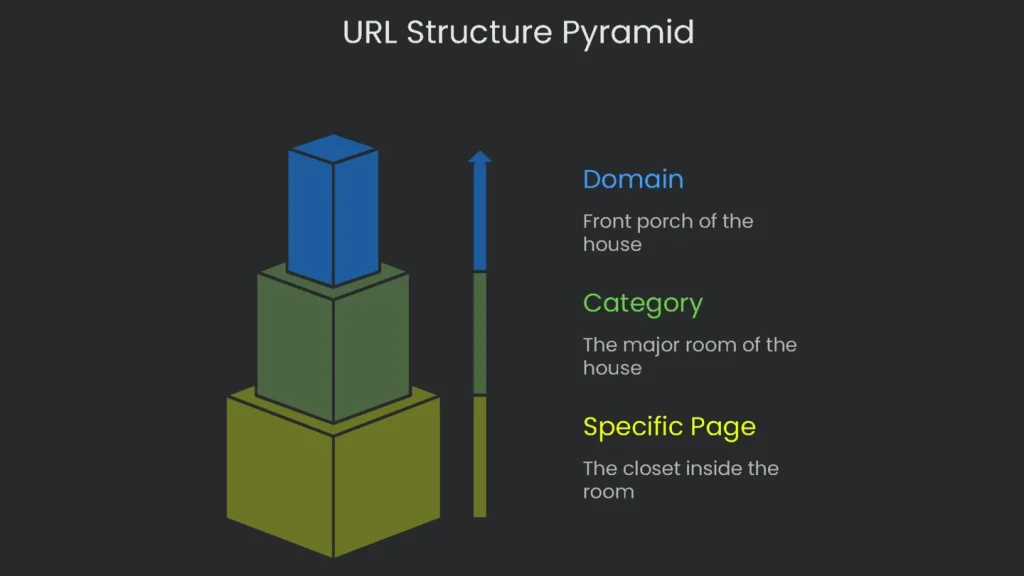
Think of URLs as the street signs of the web; the clearer they are, the easier it is for both visitors and robots to navigate. A clean, descriptive link acts like a beacon, revealing the shape and story of the entire site at a glance.
Natural Mirrors of Your Structure
URLs should mirror your site’s triangle shape from the tip to the base. When someone glances at a URL, they should be able to guess the page’s topic and its rank in the master outline of the site. Here’s a link that works: https://technicalseoservice.com/services/speed-optimization
Breaking that down, it shows:
- Front porch of the house: the domain (technicalseoservice.com).
- The major room: the main category (/services/).
- The closet inside the room: the specific page (/speed-optimization).
This is like carrying a mini map in your pocket. Therefore, users feel at home right away, while search engines file it in the right folder with confidence.
Simple Tips for URL Wisdom
A powerful URL may seem easy, yet it has a recipe. Stick with a few tried-and-true secrets from the pros and the search engines that reward your effort:
- Clear, plain English in a link helps both visitors and search engines understand the page in one glance. Consequently, the same phrasing often shows up in search results, giving anyone browsing a teaser of the content behind the click.
- Use Hyphens to Separate Google tells us to separate words with hyphens. Hyphens act like invisible spaces, making it easier for people and Google to read the address. This works no matter how the link is shared. Instead of
/blog/site architecture guide, write/blog/site-architecture-guide. - Use Lowercase Some web servers treat uppercase and lowercase as different. This means the server could think
/About-Usand/about-usare two separate pages, which confuses search engines and risks duplicate content warnings. Therefore, stick to lowercase, like/about-us, to keep the site clear and clean. - Keep it Concise Short and sweet links are easier to read, remember, and click. Studies show shorter URLs often rank higher, probably because people prefer to share them. Consequently,
/contactbeats/information-on-how-to-contact-our-team. - Mirror Site Hierarchy Let the URL show the site’s map. When you write
/category/sub-category/page-name, you reinforce the paths for both visitors and search robots. Therefore,/services/seo/technical-seoworks, so stick to the label. - Avoid Unnecessary Parameters URLs with multiple parameters (
?id=123) become tangled, long, and ugly. Robots may think those different IDs are separate pages, and you lose crawl budget. Consequently, lean is clean, so write/products/blue-shirt, not the long version. - Avoid Dates for Evergreen Content Dating pages like
/blog/2023/best-seo-toolsmakes the page feel old when the year changes. If the content gets dated, URLs need to be updated and redirected. Therefore, let’s not add this step./blog/best-seo-toolsis timeless.
Following these seven guidelines means your links are tools for visitors and allies for search engine optimization.
Purposeful Internal Linking
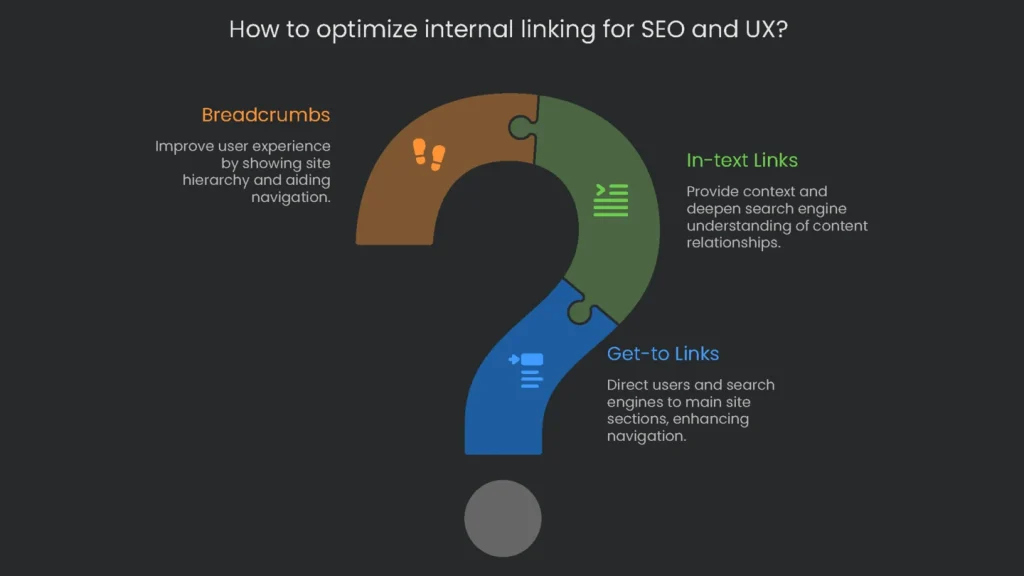
Think of your website like a body: the structure is like bones, but the internal links are the ligaments that keep everything in place. They help visitors walk from page to page, help PageRank get shared evenly, and show search engines how your content is organized.
Different Kinds of Internal Links
There are two big categories of internal links, and each one does a separate chore.
- Get-to Links: These are the links that live in your header, footer, and sidebar menus. They’re the road signs that point visitors—and search engines—straight to the main sections of your site, like the home page, the services page, and the About page.
- In-text Links: These pop up inside your articles. When a blog post links to a related service page, that’s an in-text link. Why are they so special for SEO? Because they explain exactly how one page relates to another, so search engines can learn the page’s content more deeply.
Label Your Links
The little words you click on—the anchor text—work like a name tag for a link. If your link says “best emergency plumbing service,” that phrase tells Google exactly what the linked page is about. Use meaningful anchor text to give clear signals, and you’ll direct search engines more effectively. For example, when you highlight a link with the phrase “our website speed optimization services,” you’re letting Google know the page you’re pointing to specializes in that area. This descriptive anchor text helps both people and search-engine robots understand the link’s purpose quickly and easily.
The Importance of Breadcrumbs
Want to see them in action? Check out the breadcrumb example at the top of this page. They look like trail markers that remind you where you are in a forest of web pages. Shown just beneath the header, they let you track your spot on the wider site map. Consequently, you can click any link to jump to the next-level page without fuss.
- For User Experience (UX): Breadcrumbs are like a map in a theme park. They show you the way back to major attractions, keeping you from wandering in circles. This small tool can lower the percentage of people who leave the site in a hurry. It also encourages them to wander a little more—maybe browsing that “speed optimization” link you just added.
- For Search Engine Optimization (SEO): Breadcrumbs act like digital breadcrumbs that guide both users and search engines through your website. When you set them up correctly, Google sees your site’s path more clearly and might show the breadcrumbs in search results, which can make people more likely to click.
The usual format follows a hierarchy—Home > Services > SEO—though online stores often use filters—Home > Shoes > Men > Size 10—that show how visitors narrowed their choice.
A thoughtful internal linking plan can quietly direct PageRank and build your site’s name as an expert in certain subjects. Say your most popular blog post gathers a lot of incoming links; its authority now matters. Adding a thoughtful link from that post to a newly created service page passes some of that authority along. Consequently, the new page gets a boost compared to starting from scratch. This ties the specialized page back to the core “pillar” page. As a result, search engines see a well-described expertise network and regard your site as a deeper reference.
How to Plan Your Site Architecture

Good site architecture starts with a structured plan. It reshapes business aims and visitor questions into blueprints for designers and developers. Therefore, start with audience needs and end with clear, build-ready specs.
Connect Content to User Questions
You don’t begin building a site by doodling flowcharts on a whiteboard. You start by listening to the people who will use it. Good structure is less about fancy graphics and more about giving your visitors the articles and resources they actually want.
Begin by diving into thorough keyword research. The aim here is not to collect data for the sake of it; it’s to answer the topics and the “hows” and “whys” your audience types into search bars. Examining the phrases they use reveals both the language and the unspoken goals behind every search. Once you have a comprehensive list of phrases, sort them into clusters of related ideas. Consequently, organizing this data prevents you from building pretty boxes no one will click. Instead, every page roots in real visitor needs.
Sketch the Structure
After carving out the main ideas of your site, the next move is to put it on paper in a format everyone can see. You’re turning those clusters into an actual blueprint everybody can follow.
- Mind Maps: At the start, a mind map serves as a fast and tidy way to show how every part of the site links together. Grab a tool like Miro. Place the homepage in the middle dot. Next, branch out to every main topic you’ve identified, then sprout sub-topics beneath each. The beauty of this technique is you can drag topics around, explore arrangements, and spark simple ideas because the format is flexible.
- Spreadsheets: Once you’ve sketched the overall outline, a spreadsheet fills in the nitty-gritty pieces that turn the map into something you can follow. List every part of the site in tabular form, adding columns for the page level in the hierarchy, the page title, focus keyword, and the address you plan to use. Consequently, this level of detail becomes the handbook for writers and coders when the project switches to the build stage. You can keep it tidy using tools.
Lock in URLs and Internal Links
The closing planning stage polishes the tiny details. Refer to the finished hierarchy chart to set the exact web address for every page, sticking to the URL tips we covered earlier. After that, draft your internal linking plan. Stop thinking of it as just the menu. For the pages that matter most, pinpoint other pages that ought to refer to them. Consequently, this mapping lays out the topic clusters and the flow of authority we covered in Principle 4. Logging these links in your spreadsheet bakes the work in instead of bolting it on later.
Your Website’s Design Is Your North Star
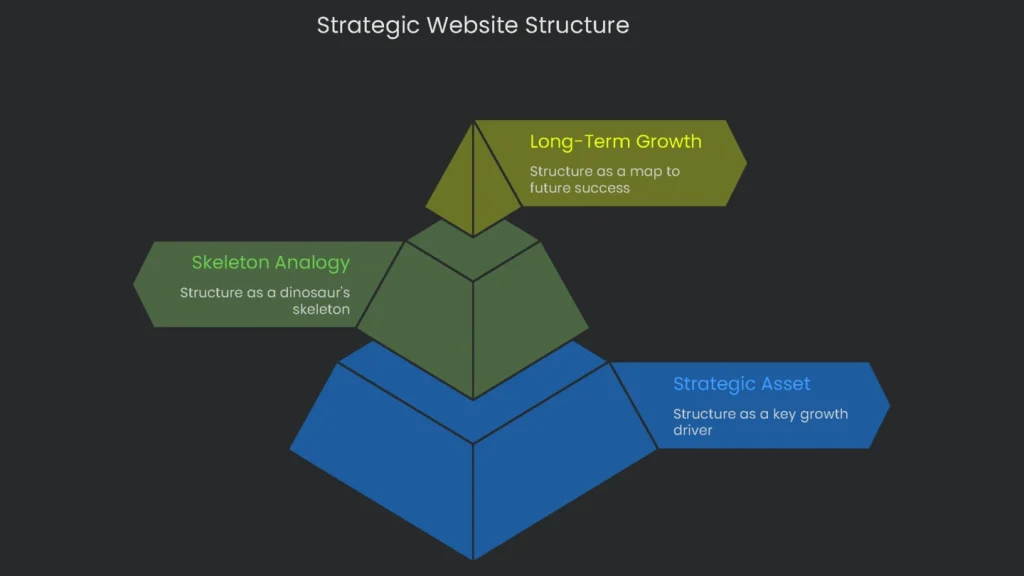
Why Structure Guides Growth
A website’s design isn’t just pixels and code; it’s the secret map to long-term growth. Think of it like the skeleton of a dinosaur. You can’t see it from the outside, but it decides what the creature can do and, ultimately, whether it survives. Therefore, treat structure as a strategic asset, not a paint job.
Four Must-Haves for Site Architecture

Quick Recap
A winning design rests on four solid ideas:
- A Pyramid: Stack content like a giant, logical pyramid so each level supports the one above.
- Close Neighbors: Make the site “flat” so key pages stand side-by-side, not buried like lost treasure.
- Bright, Simple Paths: Write URLs that read like street signs, tracing the same shape as the site’s pyramid.
- Glue Between the Blocks: Create links on every page that pull visitors along like breadcrumbs and pass authority like secret handshakes.
Rewards of Planning
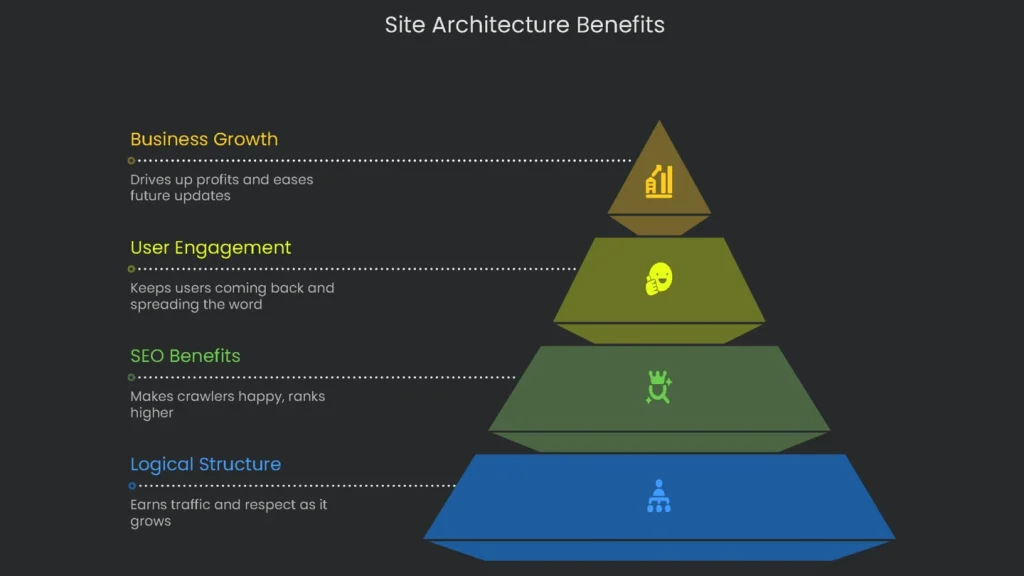
SEO Benefits
You don’t just design; you stash a treasure map in the ground. A logical structure earns more traffic and respect as it grows. The pyramid shape makes crawlers happy, and the links share the site’s “cool” factor. Consequently, search engines rank it higher. That happy journey earns users, who keep coming back and spreading the word.
Business Benefits
A well-built structure thrills visitors and drives up profits. Smooth navigation keeps people clicking and nudges more of them to buy or sign up. As a result, if you lay a solid base today, future updates come easier and cheaper, so your site keeps growing without piling up hidden costs.
Draft your master plan with us
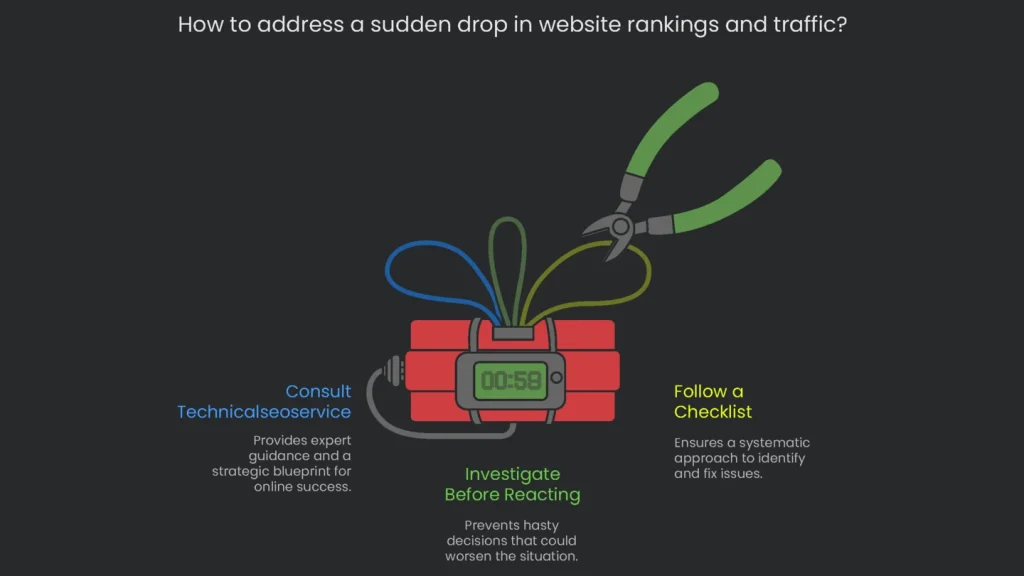
Work With Technicalseoservice
Creating a bulletproof site map means knowing how search engines crawl, what makes customers feel at home, and what your business hopes to achieve. The team at Technicalseoservice brings all those pieces together. Therefore, let us sketch a rock-solid blueprint so you have a sturdy launch pad for every future step your brand takes online.
Implementation steps
- Sketch a pyramid: Home → Categories → Subcategories → Details, steering users to almost any page within three to four clicks.
- Give every page one clear parent, cutting loose any orphans or cycles in the structure.
- Plug in handy navigation bars, footer links, and breadcrumb trails on all page templates.
- Build topic hubs, connecting related posts and product pages to pillar pages with links using short, clear phrases.
- Run the crawler again to check that pages still load quickly and internal links favor the most important content
Frequently Asked Questions
What is 'logical' architecture?
It's a tidy site layout that looks like a pyramid, with few clicks needed and internal links built with a goal.
Why is that important?
It speeds up crawling, shares page authority more evenly, and provides a better user experience, which can lead to more conversions.
How flat should the pyramid be?
Most pages should only take 3 to 4 clicks from the homepage.
Do breadcrumbs make a difference?
Yes, they enhance user experience, clarify navigation, and can appear in search results as rich snippets.
How do I organize my structure?
Begin by grouping keywords, create a category chart in a spreadsheet, finalize the URLs, and outline the internal links.
